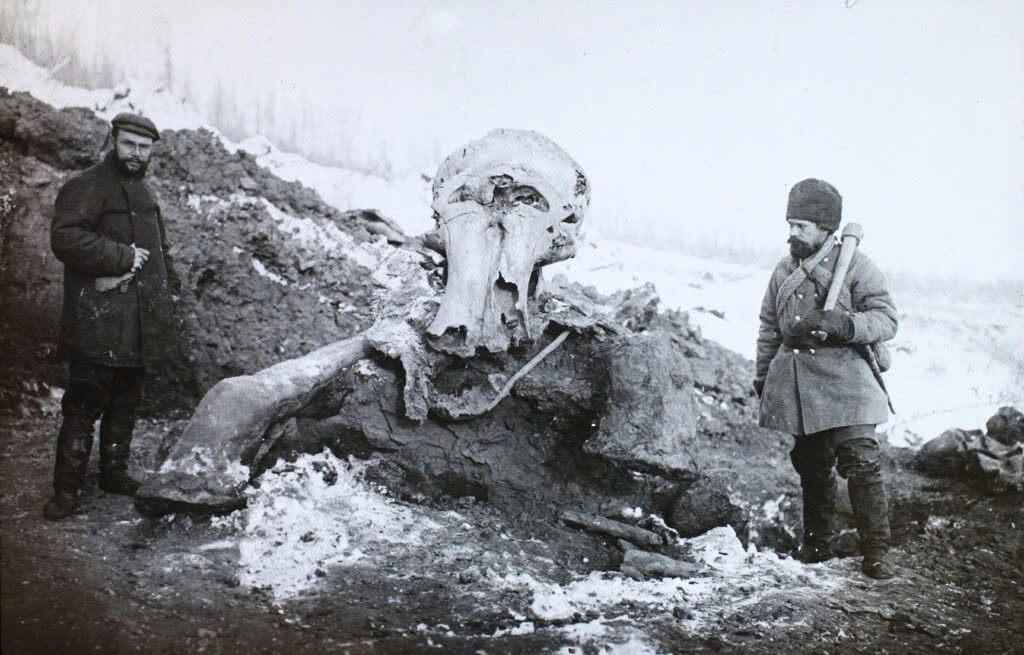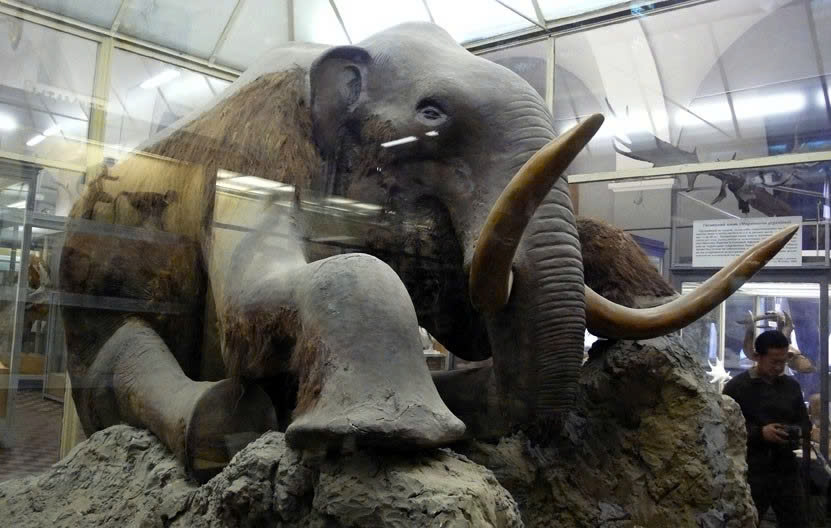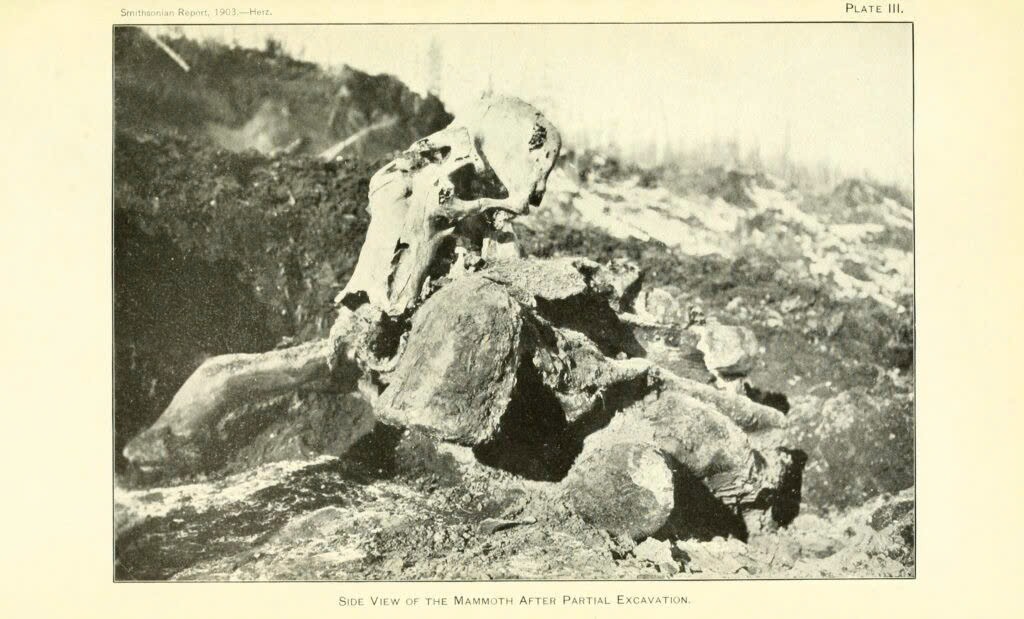Deep in the icy wilderness of Siberia, a prehistoric giant lies trapped in a moment that has endured for 44,000 years. The Beresovka Mammoth, one of the most astonishing discoveries in the history of paleontology, remains a mystery that continues to challenge scientists’ understanding of how life — and death — unfolded in the ancient world.
A Chance Discovery in the Siberian Wilderness
The Fateful Summer of 1900

It was during the brief Siberian summer of 1900 that a group of hunters traveling along the Berezovka River stumbled upon something extraordinary. From a thawing riverbank, tufts of coarse hair and fragments of bone jutted out of the frozen earth. What they had found would soon stun the scientific world — the nearly complete remains of a woolly mammoth, preserved so perfectly that it still had flowers between its teeth.
At first, the hunters thought it was simply another Ice Age carcass revealed by melting permafrost. But as they dug further, they realized this was something far rarer: the body of a mammoth frozen mid-motion, as though time itself had paused.
A Mammoth Caught Between Life and Death

When scientists later examined the find, they were astonished by the creature’s state. The mammoth sat partially upright, its thick fur still clinging to its hide, its organs and muscles preserved in remarkable detail.
The most haunting detail, however, was its final meal. Inside its mouth and stomach were fresh buttercups, sedges, and grasses — all evidence that it had been grazing peacefully when death struck. Its pelvis and ribs were fractured, and traces of blood found in its lungs suggested the end was both sudden and violent.
How could a six-ton animal die so abruptly — and freeze so perfectly — that its last mouthful of flowers remained untouched?
Racing Against Time: The Scientific Expedition
The Journey to the Frozen North
News of the discovery reached St. Petersburg within months. The Russian Academy of Sciences immediately dispatched a team led by zoologists Otto Herz and Eugene Pfizenmayer to recover the specimen before the summer thaw destroyed it.
Their expedition was an ordeal. Traveling thousands of kilometers across frozen rivers and tundra by sled, they finally arrived at the remote Berezovka site in 1901. There, encased in ice, lay a creature that had perished tens of thousands of years earlier but seemed to have died only yesterday.
A Painstaking Excavation
The scientists worked quickly and meticulously, cutting through frozen soil while documenting the mammoth’s position. The evidence told a vivid story: the animal had fallen into a depression, perhaps an ice pit or mudslide, breaking its bones in the process. Unable to rise, it suffocated as temperatures plummeted, entombing it in ice almost instantly.
After months of grueling work, the team transported the remains to St. Petersburg, where the Beresovka Mammoth was reconstructed for study. Its remains are still housed today at the Zoological Museum of the Russian Academy of Sciences — one of the best-preserved mammoths ever found.
Life in the Mammoth Steppe

The mammoth’s remains provided more than just a glimpse of a single creature — they opened a window into an entire lost ecosystem.
Around 44,000 years ago, the Siberian landscape was not the desolate tundra it is today. Instead, it was a lush grassland known as the Mammoth Steppe, stretching from Spain to Alaska. This vast biome supported enormous herds of grazing animals — mammoths, bison, horses, and reindeer — alongside formidable predators such as wolves and saber-toothed cats.
The plants found in the mammoth’s stomach painted a detailed picture of this environment: vibrant, temperate, and teeming with life. The animal’s strong teeth and thick fur suggested it was in good health — until catastrophe struck.
The Mystery of Instantaneous Preservation
Perhaps the greatest puzzle of all is how such extraordinary preservation occurred. To maintain its tissues and even delicate flowers in such pristine condition, the mammoth must have frozen within hours of death — no more than ten, according to modern decay models.
But how could such rapid freezing happen in a world without sudden cryogenic conditions?
Competing Theories
1. The Mudslide Hypothesis
The leading theory suggests the mammoth was caught in a landslide of freezing, water-saturated soil. The mud rapidly encased the body, cutting off oxygen and creating a vacuum-sealed environment. Combined with an abrupt temperature drop, the animal effectively flash-froze.
2. The Volcanic Event Theory
Another hypothesis proposes that volcanic activity triggered an atmospheric catastrophe — a burst of ash and debris that caused sudden darkness and plunging temperatures. Yet, geological evidence for such an eruption in that region and era remains inconclusive.
3. The Temperature Collapse Theory
Earlier scientists argued that a swift climatic drop — perhaps tens of degrees within hours — could have flash-frozen the mammoth. However, the presence of temperate vegetation in its stomach conflicts with the idea of an Ice Age environment turning glacial overnight.
No theory fully explains how such large, warm-blooded animals could be preserved so instantaneously. The Beresovka Mammoth remains one of the best pieces of evidence for rapid, localized catastrophes in prehistory.
Unlocking the Secrets of the Past
The Beresovka Mammoth’s remains continue to yield new scientific insights more than a century after their discovery.
Advances in genetic sequencing have allowed researchers to extract DNA from its tissues, helping trace the evolutionary links between mammoths and modern elephants. Its stomach contents, analyzed under modern microscopes, reveal pollen grains, fungal spores, and plant fragments that allow scientists to reconstruct the Ice Age climate with remarkable accuracy.
Each layer of ice, each blade of grass, tells a story — not just of a single animal, but of an entire vanished world.
A Climate Time Capsule
In an age of accelerating global warming, the mammoth’s story carries renewed urgency. The same permafrost that once entombed this creature is now thawing, revealing more frozen remains but also releasing ancient bacteria and carbon long locked away.
As researchers study these specimens, they are not just uncovering prehistory — they are glimpsing Earth’s future. The Beresovka Mammoth stands as both a scientific treasure and a warning about the delicate balance between life, death, and climate.
An Enduring Enigma
Despite over a century of study, one question still looms: how did it freeze so fast?
Every attempt to explain it leads to deeper mysteries — sudden catastrophe, geological upheaval, or perhaps environmental conditions lost to time. Whatever the answer, the mammoth’s preservation challenges our understanding of how life interacts with the forces of the natural world.
A Symbol of Wonder and Discovery
Today, visitors to the St. Petersburg Zoological Museum can still look upon the Beresovka Mammoth’s reconstructed form — a creature caught forever between motion and stillness. The buttercups found between its teeth remain one of the most poignant symbols in paleontology, a snapshot of life halted mid-breath.
The mammoth reminds us that even in death, nature can speak across millennia — if we know how to listen.
Sources
- Smithsonian Magazine – The Mystery of the Beresovka Mammoth
- BBC Earth – The Mammoth Frozen in Time
- National Geographic – Mammoths of the Ice Age
- The Guardian – Siberia’s Frozen Giants and the Science of Preservation
- Russian Academy of Sciences – Zoological Museum Archives
